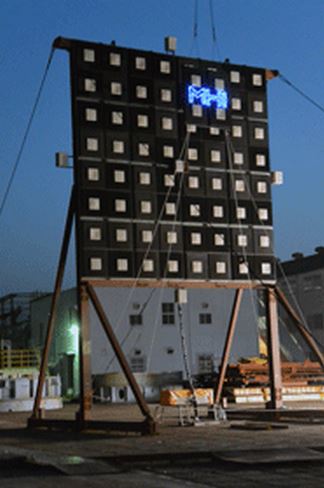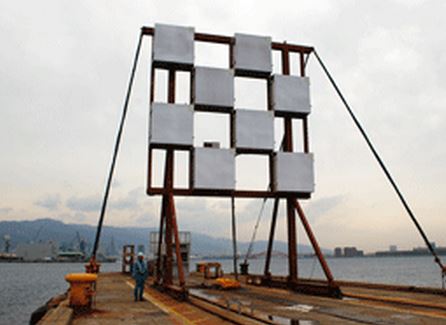The prospect of having a power plant in space beaming solar power straight down to earth with no need for cables has come a step closer, says Japanese engineering giant Mitsubishi, after successfully transmitting energy wirelessly on a smaller scale.
In a pioneering experiment at its Kobe Shipyard & Machinery Works, Mitsubishi Heavy Industries managed to power LED lights by transmitting a 10-kilowatt microwave wirelessly through air to a receiver 500 metres (1,640 feet) away.
This is the first step towards beaming power across several thousands of kilometres wirelessly.

Mitsubishi scientists were overjoyed when the LED lights lit up. (Image: Mitsubishi)
Mitsubishi Heavy Industries (MHI) wrote in a statement:
“The transmission distance and power load mark new milestones in Japan with respect to length and volume of wireless power transmission.”
“The testing also confirmed the performance of the advanced control system technology used to regulate the direction of the microwave beam so that it does not veer from the targeted receiver unit.”
The ground demonstration test was conducted based on an agreement with Japan Space Systems, the incorporated foundation that has been given the task of carrying out the ‘2012 Solar Power Wireless Transmission Technology Development Project’ by the Japanese Ministry of Economy, Trade and Industry.
Transmitting power with no cables
The aim of wireless power transmission technology is to do away with cable connections that are currently required for transmitting power. The latest successful test results lead the way to applying the technology in a number of terrestrial fields, MHI said.

10 kilowatts of power was sent from a transmitting unit by microwave. (Image: Mitsubishi)
When wireless power transmission can be done over long distances, not only will this be useful for remote or hard-to-get-to locations, but also for the transmission of power from distant generators, such as offshore wind turbines and other future applications.
MHI wrote:
“One readily conceivable application is wireless transmission of power to electric vehicles.”
Experts say electric car sales have been slow to take off because we don’t have the infrastructure to support charging stations. This new technology would solve that problem.
Beaming power from space
The wireless technology the company is developing for space solar power systems (SSPS) is called radio emission technology. Once this technology has been achieve, wireless power will be beamed over unprecedented distances.
The SSPS scientists are developing a system that should eventually be able to generate power on a geostationary satellite 36,000 kilometers above the Earth. Its solar cells will absorb the Sun’s rays to generate power that will be transmitted to Earth by microwave/laser – with no cables. The power will be converted to electrical energy on the ground.
Given that the power source is environmentally clean and infinite, the SSPS will probably become the mainstay energy source of the future that will solve our current environmental and energy challenges, MHI informed.
MHI wrote:
“Going forward MHI aims to pursue expanded practical applications of this advanced aerospace technology in a quest to contribute to social progress, while simultaneously further advancing Japanese technology toward the realization of tomorrow’s SSPS’s.”
Imagine your home with no wire clutter – bliss!

